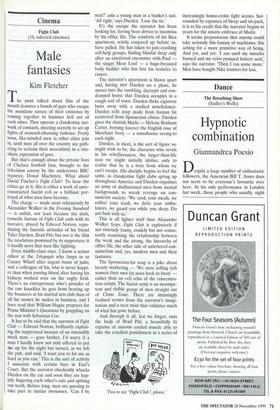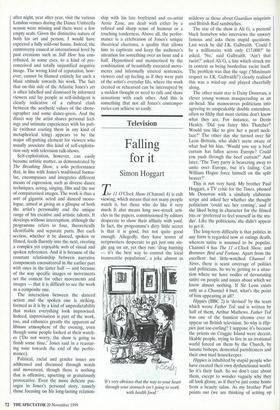Dance
The Breathing Show (Sadler's Wells)
Hypnotic combination
Giannandrea Poesio
Despite a large number of enthusiastic followers, the American Bill T. Jones does not seem to be everyone's favourite over here. At his only performance in London last week, those people who usually, night
after night, year after year, visit the various London venues during the Dance Umbrella season were missing and there were a few empty seats. Given the distinctive nature of both his art and person, I would have expected a fully sold-out house. Indeed, the controversy caused at international level by past creations such as Still Here has con- tributed, in some eyes, to a kind of pre- conceived and totally unjustified negative image. The wrong kind of reputation, how- ever, cannot be blamed entirely for such a blasé attitude towards his work. The fact that on this side of the Atlantic Jones's art is often labelled and dismissed by informed viewers and lay people as self-indulgent is clearly indicative of a cultural clash between the aesthetic values of the chore- ographer and some dance-goers. And the direct way the artist shares personal feel- ings and intimate experiences with his pub- lic (without coating them in any kind of metaphorical icing) appears to be the major off-putting element for viewers who usually associate this kind of self-exploita- tion only with television talk-shows.
Self-exploitation, however, can easily become artistic matter, as demonstrated by The Breathing Show, a solo performance that, in line with Jones's traditional formu- lae, encompasses and integrates different means of expression, such as diverse dance techniques, acting, singing, film and the use of computerised images. The work is thus a sort of gigantic acted and danced mono- logue, aimed at giving us a glimpse of both the artist's personality and the unique range of his creative and artistic talents. It develops without interruption, although the programme refers to four, theoretically identifiable and separate parts. But each section, whether it be danced, spoken or filmed, feeds fluently into the next, creating a complex yet enjoyable web of visual and spoken references. And it is because of the constant relationship between narrative components encountered in the earlier part with ones in the latter half — and because of the way specific images or movements set the context for other movements and images — that it is difficult to see the work as a composite one.
The interaction between the danced action and the spoken one is striking, formed as it is by a kind of unpredictability that makes everything look improvised. Indeed, improvisation is part of the work, too, and enhances greatly the apparent ad libitum atmosphere of the evening, even though some people looked at their watch- es ('Do not worry, the show is going to finish some time,' Jones said in a reassur- ing tone towards the end of the perfor- mance).
Political, racial and gender issues are addressed and discussed through words and movement, though there is nothing that is offensive, upsetting or gratuitously provocative. Even the more delicate pas- sages in Jones's personal story, namely those focusing on his long-lasting relation-
ship with his late boyfriend and co-artist Arnie Zane, are dealt with either by a refined and sharp sense of humour or a touching tenderness. Above all, the perfor- mance is a celebration of Jones's unique theatrical charisma, a quality that allows him to captivate and keep the audience's attention for something over an hour and a half. Hypnotised and mesmerised by the combination of beautifully executed move- ments and informally uttered sentences, viewers end up feeling as if they were part of the artist's everyday life, where the work created or rehearsed can be interrupted by a sudden thought or need to talk and share sensations with each other. And this is something that not all Jones's contempo- raries can achieve so easily.



























































































 Previous page
Previous page